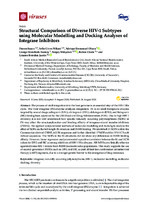| dc.contributor.author | Isaacs, Darren | |
| dc.contributor.author | Mikasi, Sello Given | |
| dc.contributor.author | Obasa, Adetayo Emmanuel | |
| dc.date.accessioned | 2021-01-06T07:04:19Z | |
| dc.date.available | 2021-01-06T07:04:19Z | |
| dc.date.issued | 2020 | |
| dc.identifier.citation | Isaacs, D. et al. (2020). Structural comparison of diverse HIV-1 subtypes using molecular modelling and docking analyses of integrase inhibitors. Viruses ,12(9),936 | en_US |
| dc.identifier.issn | 1999-4915 | |
| dc.identifier.uri | 10.3390/v12090936 | |
| dc.identifier.uri | http://hdl.handle.net/10566/5568 | |
| dc.description.abstract | The process of viral integration into the host genome is an essential step of the HIV-1 life cycle. The viral integrase (IN) enzyme catalyzes integration. IN is an ideal therapeutic enzyme targeted by several drugs; raltegravir (RAL), elvitegravir (EVG), dolutegravir (DTG), and bictegravir (BIC) having been approved by the USA Food and Drug Administration (FDA). Due to high HIV-1 diversity, it is not well understood how specific naturally occurring polymorphisms (NOPs) in IN may affect the structure/function and binding affinity of integrase strand transfer inhibitors (INSTIs). We applied computational methods of molecular modelling and docking to analyze the effect of NOPs on the full-length IN structure and INSTI binding. We identified 13 NOPs within the Cameroonian-derived CRF02_AG IN sequences and further identified 17 NOPs within HIV-1C South African sequences. The NOPs in the IN structures did not show any differences in INSTI binding affinity. However, linear regression analysis revealed a positive correlation between the Ki and EC50 values for DTG and BIC as strong inhibitors of HIV-1 IN subtypes. All INSTIs are clinically effective against diverse HIV-1 strains from INSTI treatment-naïve populations. This study supports the use of second-generation INSTIs such as DTG and BIC as part of first-line combination antiretroviral therapy (cART) regimens, due to a stronger genetic barrier to the emergence of drug resistance. | en_US |
| dc.language.iso | en | en_US |
| dc.publisher | MPDI | en_US |
| dc.subject | Diversity | en_US |
| dc.subject | HIV-1 | en_US |
| dc.subject | Molecular docking | en_US |
| dc.subject | Molecular modelling | en_US |
| dc.subject | Naturally occurring polymorphisms | en_US |
| dc.title | Structural comparison of diverse HIV-1 subtypes using molecular modelling and docking analyses of integrase inhibitors | en_US |
| dc.type | Article | en_US |

